2025-12-19 21:01:22
Welcome to the Free edition of How They Make Money.
Over 250,000 subscribers turn to us for business and investment insights.
In case you missed it:
Amazon is reportedly negotiating a $10 billion investment in OpenAI, effectively mirroring the strategy Microsoft executed just last month.
Microsoft went all-in on OpenAI first ($13 billion), then hedged by backing Anthropic ($5 billion).
Amazon bet big on Anthropic first ($8 billion), and is now potentially hedging by backing OpenAI ($10 billion).
The era of exclusive AI marriages is over. Cloud giants have realized that picking a single winner is too risky. Instead, they are becoming arms dealers. Whoever prevails in the model war, the underlying cloud infrastructure wins. That’s particularly critical for Amazon’s custom Trainium chip, which OpenAI reportedly plans to use.
Meanwhile, OpenAI needs to raise hundreds of billions to fund its CapEx ramp. It also reinforces the growing trend of circular financing in AI. Just last month, OpenAI signed a $38 billion multi-year deal with AWS.
OpenAI once again demonstrates its ability to secure commitments. Tech giants are effectively tying part of their success to OpenAI’s ability to scale.
The Information also reports that OpenAI and Amazon are discussing commerce partnership opportunities. Plot twist?
Today at a glance:
ServiceNow On a Buying Spree
Enterprise Software “Show Me” Era
Micron’s Shocking Guidance
ServiceNow (NOW) shares plunged nearly 12% on Monday, wiping out $21 billion in market cap for the software giant, and have not recovered since.
So what happened? The trigger may have been a report that the company is in advanced talks to acquire cybersecurity firm Armis for $7 billion. But it was likely less about the news itself, and more about a sum of developments of late:
💰 M&A overload: Armis would be the fourth sizable acquisition this year. Critics worry this aggressive spree signals that organic growth is harder to come by and that management is scrambling to make moves.
Armis (rumored): ~$7 billion: Asset intelligence & cybersecurity.
Moveworks: $2.85 billion: AI agents for employee support.
Veza: ~$1.5 billion (estimate): Identity security & authorization.
Logik.io: $506 million: AI-powered Configure, Price, Quote (CPQ).
👔 KeyBanc downgrade: Analyst Jackson Ader raised concerns that AI could reduce IT back-office headcount, shrinking ServiceNow’s core total addressable market (TAM).
The reality check: Despite jittery sentiment, ServiceNow has been growing its top line by more than 20% (twice the pace of peers like Salesforce and Adobe), and cybersecurity remains a top priority for enterprise budgets. Management may simply be taking advantage of a more lenient regulatory environment for tech mergers.
Is the panic justified? Not if you look closely at the business momentum.
Here’s what we wrote for PRO members after the company’s earnings last month.
🧑💻 ServiceNow: AI Fuels Blowout
ServiceNow delivered another stellar quarter, with Q3 revenue rising 22% Y/Y to $3.4 billion ($50 million beat) and adjusted EPS soaring 30% Y/Y to $4.82 ($0.55 beat). The outperformance was driven by accelerating AI adoption and strong enterprise demand. Subscription revenue grew 22% to $3.3 billion, and cRPO climbed 21% to $11.3 billion. Large customer momentum continued, with customers spending over $5 million in ACV growing 18% Y/Y to 553.
Management highlighted exceptional AI traction, noting its AI products are on pace to exceed $0.5 billion in ACV this year, tracking ahead of plans. Reflecting this strength, ServiceNow raised its FY25 guidance significantly: Subscription revenue is now expected at ~$12.84 billion ($55 million midpoint raise), operating margin guidance was lifted 50bps to 31%, and free cash flow margin guidance jumped 200bps to 34%. Q4 guidance also points to continued strong growth (~19.5% subscription revenue).
ServiceNow’s board authorized a five-for-one stock split, pending shareholder approval. While management prudently factored potential government deal timing delays into Q4 guidance, the beats put the company on a strong trajectory.
The market has spent the last year punishing software stocks that promised an AI revolution but delivered only incremental features. Investors have largely dumped shares of any company that couldn’t draw a direct line between GPU spend and ARR growth, while OpenAI and Anthropic are sucking all the air in the room.
While hyperscalers (Microsoft, AWS, Google, Meta) have captured most of the upside (as reflected in growth acceleration), some pure-play companies in the platform and apps categories have emerged. Notably, Palantir, Salesforce, and Databricks have all crossed the $1 billion AI revenue run rate milestone.
Palantir ($1.6 billion US Commercial run rate): The standout performer. Their AIP Bootcamps strategy has successfully converted pilot programs into committed revenue, driving US Commercial growth to 121%.
Salesforce ($1.4 billion Agentforce + Data): By bundling their new Agentforce with the less glamorous but essential Data Cloud, they generated $1.4 billion in annualized AI-related ARR, growing 114%. However, the market has focused on the overall organic growth (now at 9% excluding Informatica) and remains skeptical.
Databricks (>$.1.0 billion run rate from AI products): The Data and AI company just announced a $4 billion Series L investment, valuing the company at $134 billion. They crossed $4.8 billion in overall revenue run-rate in Q3, growing over 55% Y/Y.
Here’s a look at the other large movers.
As you can see, the aforementioned ServiceNow follows, alongside Adobe. The latter has been deemed the ultimate AI victim, though the jury is still out.
The data highlights a critical divergence: software incumbents are not building flashy models. Instead, they are capturing the “boring” enterprise context that makes those models useful.
Companies like ServiceNow and Salesforce are executing a small-ball M&A strategy by acquiring niche tools to feed their agents.
Massive acquisitions like Warner Bros. are essentially focused on the old economy.
Smaller AI acquisitions are happening weekly. They may not capture headlines, but they focus on what comes next, from data management to cybersecurity. Those are the acquisitions that can be overlooked and still deliver massive returns if integrated properly.
This unsexy integration is fueling the trifecta of software economics:
Acquisition: AI as the hook to get in the door (see Palantir Bootcamps).
Retention: Embedded agents that learn enterprise context, making them painful to rip out.
Monetization: Usage-based pricing (Databricks/Snowflake) or premium agent consumption (Salesforce) that scales with value.
If we judge the AI revolution solely by the few billions here and there directly attributed to AI products, the math looks broken. But this view misses the massive, invisible uplift in core businesses. For giants like Google and Meta, AI is the algorithm making their existing ad machines smarter, boosting revenue lines that are part of the core business. In fact, having an existing business that can be significantly enhanced by AI may be the fundamental aspect of the AI boom that favors incumbents.
Last quarter, we discussed how Micron’s reorganization revealed the HBM-powered recovery (High-Bandwidth Memory).
The company just released its Q1 FY26 earnings (ending November 2025), and the numbers shattered estimates. The story has moved from recovery to what management calls the “most significant disconnect between supply and demand in 25 years.” And while Q1 results were strong, the market was stunned by the Q2 forecast.
Wall Street expected a steady climb, but Micron delivered an explosion. The Cloud Memory unit generated $5.3 billion, a 2x year-over-year increase.
Revenue surged 57% Y/Y to $13.6 billion ($0.8 billion beat), and EPS was $4.78 ($0.82 beat). Margins continued to expand to their highest level since 2018, marking a historic expansion in profitability driven by pricing power.
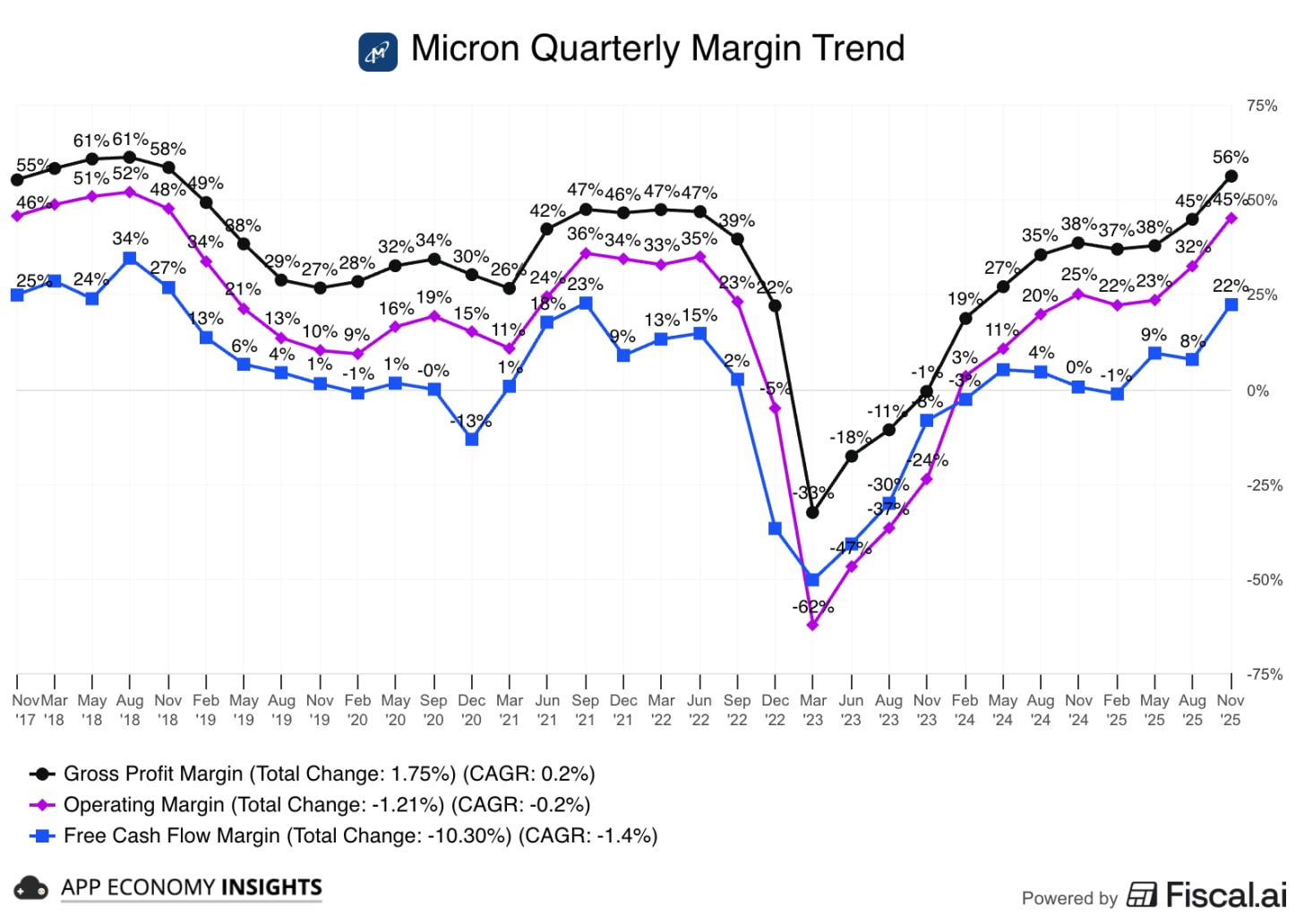
Q2 revenue forecast: ~$18.7 billion ($4.5 billion beat).
Q2 EPS forecast: ~$8.42 ($3.93 beat).
Micron’s revenue guidance was 31% higher than expectations. The forecast implies a staggerring 38% sequential revenue growth and nearly 59% operating margin. This P&L is starting to look like NVIDIA’s!
Why is guidance so high? We are officially out of chips. Executive VP Manish Bhatia described the current environment as the most severe supply/demand imbalance he has seen in his career.
HBM is sold out: Micron is sold out of HBM chips for 2026.
Rationing: CEO Sanjay Mehrotra admitted they can currently meet only 50% to 66% of demand for key customers.
As Micron shifts production lines to build complex HBM chips for AI, there is now a shortage of standard memory for PCs and smartphones. This allows Micron to raise prices across the board, not just in AI.
Despite 25 upward revisions heading into the print (usually a setup for disappointment), Wall Street still dramatically underestimated the reality.
CapEx: Micron raised its fiscal 2026 CapEx forecast to $20 billion (up from $18 billion). They are spending aggressively to build capacity in Idaho and New York.
Consumer Impact: Watch for price hikes in consumer electronics (PCs, phones) as commodity memory becomes scarce.
HBM4: Production is slated for early 2026. With current generation chips sold out, the race for next-gen allocation has already begun.
The shortage is real, the margins are historic, and the cycle is accelerating. We’ll find out next quarter if Micron was still conservative with its $18 billion promise.
Just don’t forget: memory remains the quintessential cyclical business.
That's it for today.
Happy investing!
Thanks to Fiscal.ai for being our official data partner. Create your own charts and pull key metrics from 50,000+ companies directly on Fiscal.ai. Save 15% with this link.
Disclosure: I own ADBE, AMD, AMZN, CRM, GOOG, META, NOW, PLTR, and NVDA in App Economy Portfolio. I share my ratings (BUY, SELL, or HOLD) with App Economy Portfolio members.
Author's Note (Bertrand here 👋🏼): The views and opinions expressed in this newsletter are solely my own and should not be considered financial advice or any other organization's views.
2025-12-16 21:02:56
Welcome to the Premium edition of How They Make Money.
Over 250,000 subscribers turn to us for business and investment insights.
In case you missed it:
While tech investors have been glued to AI listings, the largest deal of 2025 comes from a very different sector: Healthcare Supply.
Medline is the plumbing of the US healthcare system. If you’ve ever been to a hospital, you’ve used their products, from surgical gowns and exam gloves to anesthesia kits and wheelchairs.
In 2021, Medline was taken private in a massive $34 billion leveraged buyout (LBO) by Blackstone, Carlyle, and Hellman & Friedman. It was one of the largest LBOs since the 2008 financial crisis. Now, just four years later, the private equity giants are bringing it back to the Nasdaq.
Medline is targeting a $55 billion valuation, making it the largest IPO since 2021.
I went through the 300+ pages of Medline’s S-1 so you don’t have to.
Today at a glance:
Overview
Business Model
Financial highlights
Risks & Challenges
Management
Use of Proceeds
Future Outlook
Personal Take
Medline has been the largest privately held manufacturer and distributor of medical supplies in the United States.
Founded in 1966 by the Mills family, the company traces its roots to 1910, when A.L. Mills began making butcher aprons for the Chicago stockyards. He soon realized that surgeons needed aprons too, and a healthcare dynasty was born.
For decades, Medline operated as a family business, compounding quietly. Today, it serves the entire continuum of care: hospitals, surgery centers, nursing homes, and physician offices.
Headquarters: Northfield, Illinois.
Mission: To make healthcare run better.
Ticker: MDLN (Nasdaq).
Let’s capture Medline’s scale in a few key numbers:
335,000+ products in their catalog.
69 distribution centers globally.
2,000+ trucks in their own fleet (”MedTrans”).
Next-day delivery to 95% of the US population.
Why are we seeing an IPO now? In 2021, the Mills family sold a majority stake to private equity giants.
The goal was to accelerate global expansion and invest in infrastructure without the quarterly pressure of public markets. Now, these PE firms are looking for an exit (or at least liquidity), and the S-1 shows that their bet has paid off: Medline has grown revenue by roughly $5 billion since the buyout.
Medline operates a vertically integrated model that blends Manufacturing and Distribution.
Most competitors do one or the other.
Manufacturers: Front line care and surgical solutions providers like 3M and Becton Dickinson make the products. It’s high-margin, but they lack the direct logistics relationship.
Distributors: Supply chain solutions providers such as McKesson and Cardinal Health move boxes. It’s a low-margin, high-volume game.
Medline does both. They use their distribution network to get in the door with hospitals, then upsell them on their own high-margin private-label products.
They report in two main segments:
This is the profit engine. It includes products manufactured or sourced by Medline (surgical kits, PPE, sterile drapes).
Economics: While this is half of the revenue, it generates 84% of the EBITDA, thanks to a 27% adjusted margin.
Why it matters: By owning the manufacturing, Medline captures the margin that usually goes to third-party suppliers.
This is the logistics arm. They distribute products from other manufacturers alongside their own.
Economics: This generates only 16% of the EBITDA, with a much lower 5% adjusted margin.
Why it matters: It makes them a one-stop shop. Hospitals sign Prime Vendor contracts, designating Medline as their primary supplier.
The business thrives on a simple but powerful cycle of land and expand:
Land: A hospital signs a Prime Vendor deal for logistics efficiency.
Audit: Medline analyzes the hospital’s total spend.
Expand: The company proves it can lower costs by swapping out third-party supplies for Medline Brand alternatives (standardization).
Win-Win: The hospital cuts costs, while Medline earns higher margins.
This lock-in is incredible. Medline reports a 98% retention rate for its Prime Vendor customers over the last 5 years. Medline Brand conversion steadily increases over the tenure of a contract.
Let’s turn to the financials and where the money flows.
2025-12-13 23:02:05
Welcome to the Saturday PRO edition of How They Make Money.
Over 250,000 subscribers turn to us for business and investment insights.
In case you missed it:
📊 Monthly reports: 200+ companies visualized.
📩 Tuesday articles: Exclusive deep dives and insights.
📚 Access to our archive: Hundreds of business breakdowns.
📩 Saturday PRO reports: Timely insights on the latest earnings.
Today at a glance:
📈 Broadcom: The $73 Billion Backlog
🛒 Costco: Digital Breakout
🎨 Adobe: AI Ecosystem Expands
🧠 Synopsys: Ansys & AI Power Up
🧘🏻 Lululemon: CEO Exit & Reset
🐶 Chewy: Loyalty Pays Off
🎮 GameStop: Aggressive Cost Cutting
Broadcom’s Q4 FY25 revenue (October quarter) rose 28% Y/Y to $18.0 billion ($0.6 billion beat), and non-GAAP EPS was $1.95 ($0.08 beat).
The AI growth story remains explosive. AI semiconductor revenue surged 74% Y/Y to $6.5 billion. That helped the Semiconductor solutions segment grow 35% Y/Y to $11.1 billion. The VMware integration continued to be successful, with the Infrastructure software segment rising 19% Y/Y to $6.9 billion.
CEO Hock Tan revealed a staggering $73 billion backlog for AI products (shipping over the next 18 months), including a new $11 billion order from an existing customer (likely Anthropic) and a $1 billion win from a fifth custom chip (XPU) customer.
Broadcom forecasts Q1 FY26 revenue of $19.1 billion (well above the ~$18.3 billion consensus) and expects AI revenue to double Y/Y to $8.2 billion next quarter, while non-AI chip revenue will be mostly flat.
However, shares slid nearly 11% post-earnings. Investors seemed spooked by management’s refusal to provide a specific full-year AI revenue outlook (calling it a “moving target”) and comments that the shift toward system sales (handling the entire rack) will naturally pressure gross margins. Despite the large beat, the market now demands clearer visibility into the long-term margin profile of this AI boom.
Costco kicked off FY26 with Q1 revenue rising 8% Y/Y to $67.3 billion ($0.2 billion beat) and GAAP EPS of $4.50 ($0.22 beat). Comparable sales held steady at +6.4% globally and +5.9% in the US, showing resilience despite a tough retail backdrop.
The big story was digital acceleration. Costco introduced a new metric, Digitally-enabled sales, which grew 20.5% (a sharp jump from the ~13% e-commerce growth last quarter). This new definition now captures Same-Day Delivery (via Instacart/Uber Eats) and global Costco Travel bookings.
Management noted that under this new definition, FY25 digital sales were over $27 billion (10% of overall revenue), roughly 40% higher than the $19.6 billion reported under the old metric.
The membership engine remains powerful but showed a slight crack. Fee income rose 14% to $1.33 billion, but the worldwide renewal rate ticked down 10 basis points to 89.7%. Management attributed this slight dip to a surge in younger members signing up online, who typically renew at lower rates than in-store signups. Margins held steady as the company successfully mitigated tariff pressures to keep prices low.
Looking ahead, the pace of physical expansion is slowing slightly. Management revised its FY26 target for 20–28 net new warehouse openings (previously targeting ~30), citing construction delays.
Despite a beat-and-raise quarter, the stock reaction was muted, reinforcing that at ~44x forward earnings, Costco’s valuation remains at a historically high level.
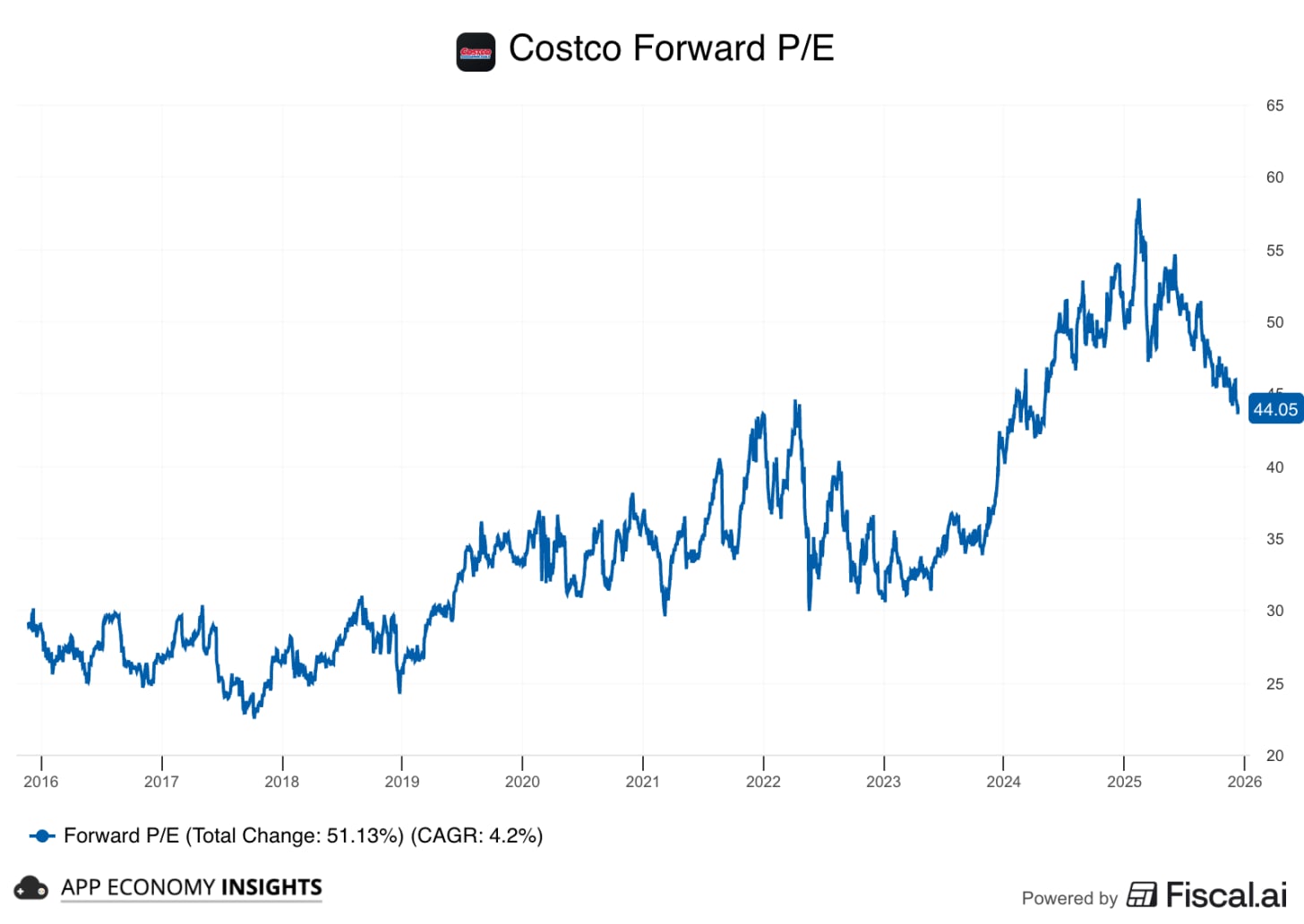
2025-12-12 21:03:40
Welcome to the Free edition of How They Make Money.
Over 250,000 subscribers turn to us for business and investment insights.
In case you missed it:
Despite another jaw-dropping surge in future contracts, Oracle shares slumped 11% following its quarterly report. With this latest drop, shares are now over 40% below their September peak.
Why? The company is betting the farm on building the AI infrastructure of the future. The backlog is surging, but so is the bill to build it.
Oracle just raised its FY26 CapEx forecast by $15 billion to $50 billion, fueling fears about debt and cash burn. Free cash flow declined to negative $13 billion over the past 12 months (negative $10 billion in the last quarter alone).
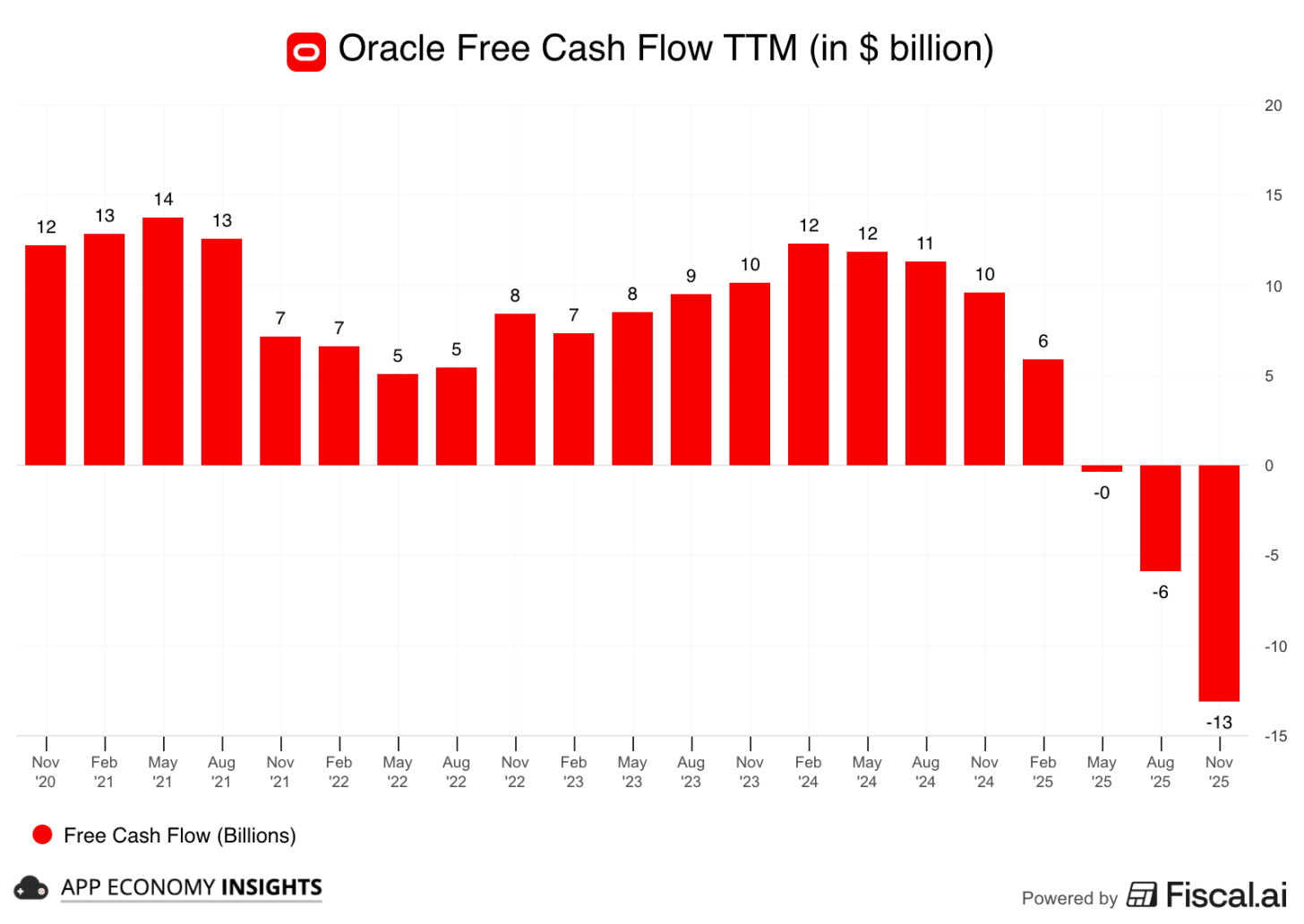
Meanwhile, actual revenue missed estimates slightly, reminding investors that signing a contract is easier than powering up a data center.
Let’s review the numbers behind the sell-off and the continued AI hypergrowth.
Today at a glance:
Oracle has something to prove
Robo-Advisor Wealthfront Goes Public
RPO surged 15% sequentially: After last quarter’s shocker, RPO (future revenue from existing contracts) grew another $68 billion in Q2 to $523 billion (+438% Y/Y). To put this in perspective, that is roughly 8x Oracle’s annual revenue. It gives tremendous visibility for the business, provided customers can pay, and Oracle can execute.
IaaS is going vertical: Oracle Cloud Infrastructure (OCI) revenue growth accelerated to 68% Y/Y (up from 55% in Q1 and 49% in Q4). This confirms that Oracle is capturing significant AI training demand, limited only by how quickly it can deploy GPUs and power.
The Ampere boost: Non-GAAP EPS beat expectations handily ($2.26 vs. ~$1.63 expected), but this included a $2.7 billion gain from selling a stake in chipmaker Ampere (buried in “other” in the top right of the visual below). Without this one-time windfall, the beat would actually be a large miss, which likely contributed to the market’s skepticism.
Income statement:
Revenue grew +14% year-over-year to $16.1 billion ($130 million miss).
☁️ Cloud grew +34% Y/Y to $8.0 billion.
🌐 Software declined 3% Y/Y to $5.9 billion.
🖥️ Hardware grew 7% Y/Y to $0.8 billion.
💼 Services grew 7% Y/Y to $1.4 billion.
The shift to IaaS compressed gross margins to 67% (-4pp Y/Y).
Operating margin was 29% (-1pp Y/Y).
Cash flow:
Operating cash flow TTM was up 10% to $22.3 billion.
Free cash flow TTM was negative $13.2 billion and remains under immense pressure due to the CapEx ramp.
The CapEx shock: Management raised the FY26 capital expenditure outlook to $50 billion. That is a $15 billion increase from the previous guide. Oracle is now spending on infrastructure at a scale rivaling the top hyperscalers (Amazon, Microsoft, Google).
Balance sheet:
Net debt: $105 billion (roughly 4x net leverage based on $26 billion EBITDA TTM).
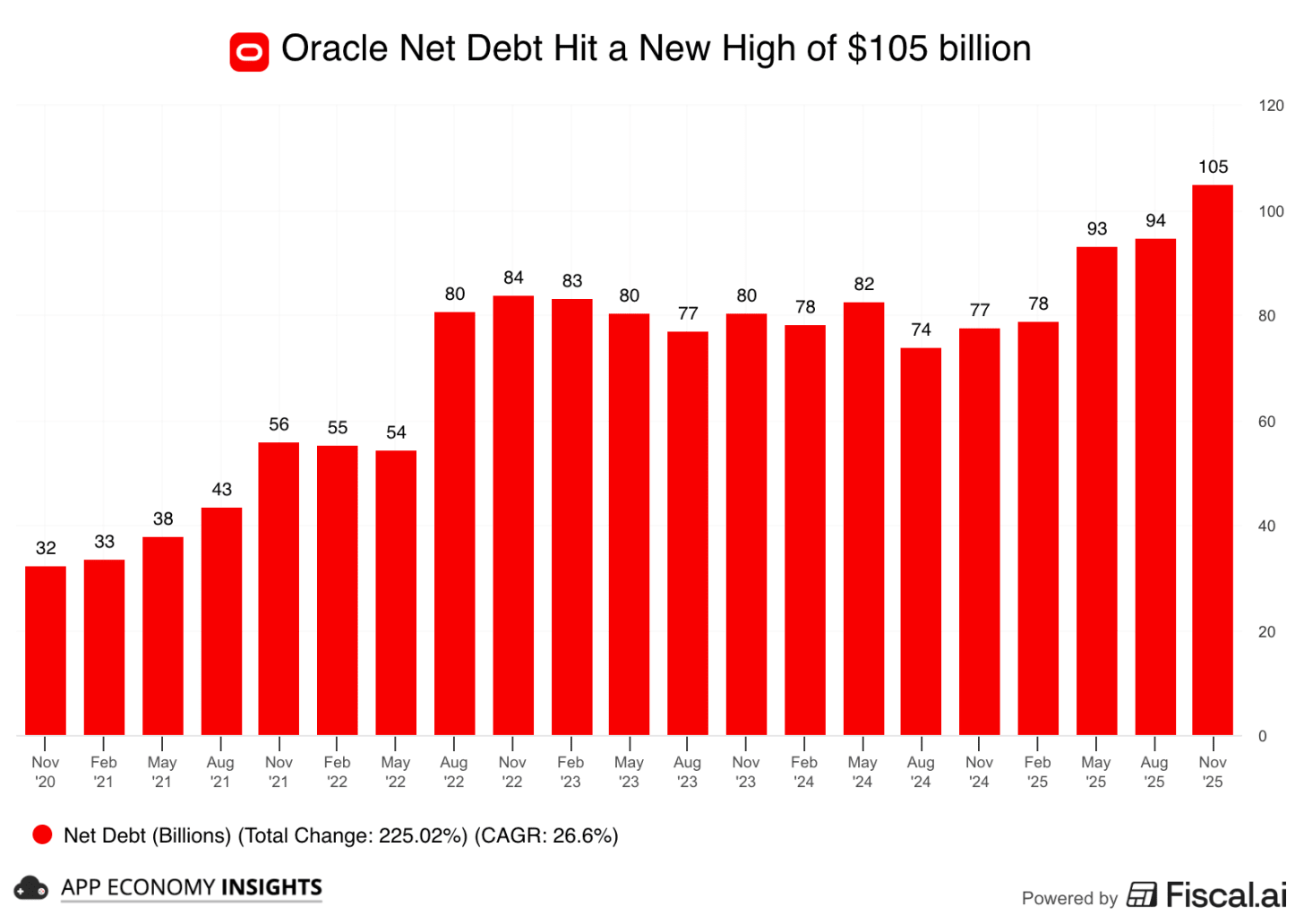
📦 Backlog is real, but timing is everything: RPO of $523 billion is an astronomical number. But Project Stargate (the OpenAI mega-deal) and others won’t turn into cash until the data centers are built. Sequential RPO growth indicates demand is not slowing.
⚡ The CapEx gamble: Larry Ellison is essentially saying, “The demand is so guaranteed, we will spend whatever it takes.” Management hinted at potential relief valves, such as leasing chips or allowing customers to bring their own, to reduce the capital burden. If the AI cycle turns, Oracle is left with massive debt and empty server racks. If it holds, they become the 4th hyperscaler.
☁️ Acceleration continues: The most bullish signal is OCI accelerating to 68% growth. This is the core thesis. Oracle is growing its cloud infrastructure faster than AWS, Azure, or Google Cloud (on a smaller base), demonstrating that its GPU Supercluster architecture is gaining share.
🏗️ Construction risk: Revenue missed slightly because you can’t bill for a data center that isn’t finished. The bottleneck has shifted from selling to building. Management cited power availability and construction timelines as the governors on growth.
📉 Quality of earnings: The stock drop reflects a sober look at the bottom line. Combined with a debt-fueled spending spree, Wall Street is demanding near-term execution over long-term promises.
Burn rate: Can Oracle fund $50 billion in CapEx without putting its dividend or credit rating at risk? Management avoided answering exactly how much capital they need to raise, so watch closely for debt issuance or even equity dilution.
Conversion speed: How fast does that $523 billion RPO turn into OCI revenue? We need to see IaaS revenue accelerate toward the $5-6 billion quarterly run rate to justify the spend.
Software drag: While IaaS rockets, the traditional business (License/Support/SaaS) is flat to down. Oracle needs the old business to keep printing cash to fund the new business. If the legacy business erodes too fast, the math gets harder.
Takeaway: The narrative is intact, but the price of admission keeps going up. Oracle is growing faster than ever in the cloud, but it is now leveraged to the hilt on the AI boom. It’s a high-risk, high-reward transition.
📊 Want to see how AMD and NVIDIA recently performed? Check out our latest monthly Earnings Visuals report.
Three years ago, Wealthfront was supposed to disappear. The original robo-advisor had agreed to be acquired by UBS for $1.4 billion, acknowledging that the path to independence was too steep.
But after the deal collapsed in 2022, Wealthfront pivoted.
Today, the company is going public with an IPO targeting a $2 billion valuation under the ticker WLTH. By walking away from the acquisition and betting on itself, the company has effectively created ~$600 million in shareholder value during a brutal fintech winter.
For years, Wealthfront was known as the pioneer of automated investing, collecting a modest 0.25% fee to manage your ETF portfolio. But if you look under the hood of their S-1, you’ll find a very different business model driving the returns today.
How did they pull it off? They stopped being just an investment manager and started acting like a bank.
The narrative used to be about “assets under management” (AUM) and advisory fees. While those are still growing, they are no longer the main event.
In the most recent quarter (Q2 FY26, ending July 2025), Wealthfront reported $91 million in net revenue. Here is the breakdown that matters:
Cash Management: $69 million (~76% of revenue).
Investment Advisory: $22 million (~24% of revenue).
The takeaway? Wealthfront makes three times more money from the cash sitting in your high-yield account than it does from managing your investments.
This shift occurred when they launched their cash account, leveraging partner banks to offer high yields. By capturing the spread (the difference between what they earn on client cash and what they pay out in interest), they unlocked a massive, high-margin revenue stream.
Unlike the wave of cash-burning fintech IPOs we saw in 2020 and 2021, Wealthfront is structurally profitable.
Net income: They generated $39 million in EBIT (earnings before interest and taxes) last quarter alone, with a pristine 38% net profit margin.
Demographics: They have 1.3 million funded clients, heavily skewed toward Millennials and Gen Z, a cohort entering their prime earning years.
Retention: Their “Net Dollar Retention” is over 120%. This means existing customers are adding more money to the platform every year, fueling growth without Wealthfront having to spend a dime on marketing to them.
The very thing that makes Wealthfront a cash cow today is also its biggest risk. In 2022, Wealthfront was a slowing advisory business (growing just 16% Y/Y according to private market research from Sacra). The pivot to cash management, capitalizing on high interest rates, is behind the acceleration.
But this profitability is tied directly to the Federal Reserve. When rates are high, Wealthfront earns a fat spread on $47 billion in cash assets. If the Fed cuts rates significantly, that revenue stream shrinks automatically.
Investors buying WLTH are effectively betting that the company can cross-sell these cash-parking clients into fee-paying investment accounts before high yields disappear.
Takeaway: At a $2 billion valuation, Wealthfront is priced as a comeback story. They walked away from a $1.4 billion acquisition and nearly tripled their revenue in three years. It offers a rare combination of growth and GAAP profitability.
However, the identity crisis remains. Is this a technology platform revolutionizing wealth management? Or is it a beautifully designed interface for cash arbitrage?
The market (and the Fed) will decide moving forward.
That's it for today.
Happy investing!
Thanks to Fiscal.ai for being our official data partner. Create your own charts and pull key metrics from 50,000+ companies directly on Fiscal.ai. Save 15% with this link.
Disclosure: I own AMD, AMZN, GOOG, META, and NVDA in App Economy Portfolio. I share my ratings (BUY, SELL, or HOLD) with App Economy Portfolio members.
Author's Note (Bertrand here 👋🏼): The views and opinions expressed in this newsletter are solely my own and should not be considered financial advice or any other organization's views.
2025-12-09 21:03:32
Welcome to the Premium edition of How They Make Money.
Over 250,000 subscribers turn to us for business and investment insights.
In case you missed it:
Netflix has entered a definitive agreement to acquire the studio and streaming assets of Warner Bros. Discovery for an enterprise value of $83 billion.
The deal covers massive intellectual property. But more importantly, the acquisition transforms Netflix from primarily a streaming-only company into a true entertainment conglomerate, expanding its risk profile and strategic direction.
But it is far from a done deal. An FTC review is inevitable. President Trump has already weighed in, stating the acquisition “could be a problem.” Adding to the chaos, Paramount just launched a hostile takeover.
In a world where Microsoft can buy Activision Blizzard, the vertical nature of the Netflix-Warner merger could be a critical edge. Remember, HBO Max captures only ~1% of US TV time, making it the 9th largest streamer on TV, according to Nielsen. But it brings theatrical distribution and licensing muscles in which Netflix historically plays a small part.
Warner Bros. is actively for sale. Regulators may have a hard time arguing that a Netflix acquisition is worse for the industry than a Paramount or Comcast deal. In fact, those would be horizontal mergers between direct competitors (studio and networks), arguably more problematic.
Let’s unpack the deal, the drama, and the data.
Today at a glance:
What Netflix is buying
Netflix embraces leverage
The end of Build vs. Buy
The real value beyond IPs
Antitrust and execution risks
Who wins & who loses
FROM OUR PARTNERS
Most firms quietly take 1–2% AUM forever. On a $2 million portfolio, that’s $20k–$40k+ gone every single year — enough to fund a luxury car, a dream vacation, or an extra decade of retirement.
Range doesn’t play that game.
No AUM fees. Just one flat, transparent annual membership fee for unlimited access to a team of human financial advisors + 24/7 access to RAI, your AI wealth advisor. You get institutional-grade tools once reserved for billionaires: direct indexing, real-time tax-loss harvesting, daily rebalancing, and a single dashboard that unites your crypto, real estate, RSUs, and 401(k)s.
Built exclusively for high-earning households.
Your money compounds. Legacy fees don’t.
Disclosure: Not investment advice. Brokerage fees, transaction charges, and other applicable platform fees imposed by our custodian are not included in your membership and will be passed through to you as the Member. Visit www.range.com for details.
The deal involves two steps for current Warner Bros. Discovery (WBD) shareholders expected in the next 12 to 18 months.
Before the Netflix acquisition closes, WBD will spin off its linear networks business into a new, publicly traded independent company dubbed Discovery Global.
What it holds: The legacy cable portfolio (CNN, TNT, TBS, Discovery Channel, HGTV, Food Network) and digital assets like Bleacher Report.
For WBD shareholders: If you own WBD stock, you will receive a pro-rata distribution of shares in this new company. You effectively keep the linear business as a standalone investment.
Netflix will acquire the remaining entity:
What it holds: Warner Bros. Pictures, Warner Bros. Television, DC Studios, HBO, and the HBO Max streaming platform. That includes coveted IPs like Harry Potter, Batman, Superman, Wonder Woman, Game of Thrones, The Lord of the Rings, Monsterverse (Godzilla/Kong), The Matrix, Looney Tunes, and an avalanche of prestige TV shows.
For WBD shareholders: Netflix purchases this streamlined company for $27.75 per share ($23.25 in cash + $4.50 in Netflix stock).
In short, Netflix buys the IP engine without inheriting the dying cable bundle.
Note that Paramount’s hostile takeover is at $30/share in cash for the entire company. With the value of the Networks segment estimated at ~$5/share, this is still short of Netlfix’s bid.
Here’s how the combined revenue would look:
Netflix made ~$43 billion in the last 12 months, still growing in the mid-teens.
Warner’s Studios and Streaming segments reached ~$24 billion over the same period, mostly flat in the past two years. The majority of revenue is coming from Studios, including theatrical, licensing, and gaming.
That puts the combined entity at ~$67 billion of annual revenue. Just barely ahead of YouTube, which has an estimated ~$60 billion annual run rate (ads + subscription).

Turning to profitability, Warner’s Studios and Streaming segments achieved $4.2 billion in adjusted EBITDA in the past 12 months. Most noteworthy is the progress made in the Streaming segment as more cord-cutters switch to HBO Max (128 million subscribers globally in Q3). But the Studios segment can be hit or miss and depends on big new releases.
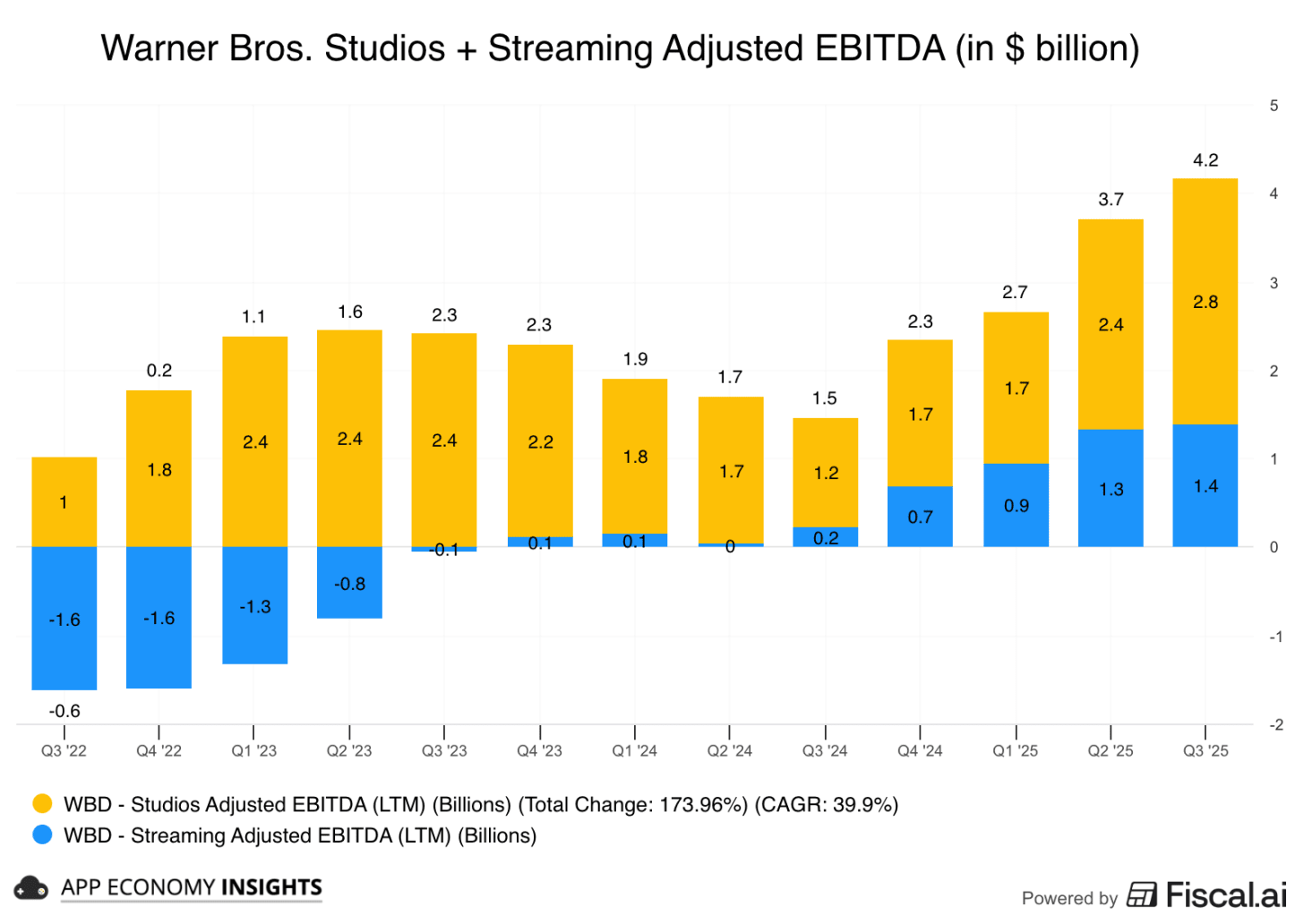
At an enterprise value of ~$83 billion, Netflix is essentially paying ~20x EBITDA. It gets to 25x if we use Warner’s expected EBITDA of $3.3 billion for FY26. That’s a big premium for a no-growth business, as you would expect after a bidding war. For perspective, Disney is currently trading at ~12x EBITDA.
Critically, Netflix expects $2-to-3 billion in annual cost savings by year 3. If they can deliver on the high end of this goal, the valuation comes down to ~12x EBITDA and makes more sense.
In addition, there is a wide range of value that could be unlocked and not reflected in trailing financial metrics:
Netflix IPs get a publishing and distribution boost via vertical integration (potential theatrical releases, licensing, gaming).
Warner Bros. IPs get to reach over 300 million Netflix members, potentially unlocking a new fanbase for century-old franchises, fueling the rest of the flywheel (more on this in a minute).
Netflix agreed to a massive $5.8 billion termination fee.
What this means: If regulators (DOJ/FTC) block the deal, Netflix must pay WBD $5.8 billion just for walking away.
The signal: This is one of the largest breakup fees in M&A history. Netflix is putting 8% of the deal’s equity value on the line (much higher than the typical 2% to 3% seen on other large deals), showing confidence they can get it done and convince regulators.
Meanwhile, if WBD shareholders vote down the deal or Warner takes a rival offer, there is a $2.8 billion reverse breakup fee. If Paramount makes another bid, it would be on the hook for that fee, making it less likely.
2025-12-06 23:00:57
Welcome to the Saturday PRO edition of How They Make Money.
Over 250,000 subscribers turn to us for business and investment insights.
In case you missed it:
📊 Monthly reports: 200+ companies visualized.
📩 Tuesday articles: Exclusive deep dives and insights.
📚 Access to our archive: Hundreds of business breakdowns.
📩 Saturday PRO reports: Timely insights on the latest earnings.
Today at a glance:
❄️ Snowflake: RPO Surge
🖥️ HPE: Networking Pivot
🔐 Okta: AI Identity in Focus
🌐 Samsara: Profitable Scale
✍️ DocuSign: IAM Acceleration
🔷 Rubrik: Cyber Resilience Breakout
🏥 HealthEquity: Assets Swell
🤖 UiPath: Agentic Surge
👁️ SentinelOne: AI Traction & CFO Exit
📝 Asana: AI Teammates Arrive
🧠 C3.ai: Stabilization Signs
Snowflake’s Q3 revenue rose 29% Y/Y to $1.21 billion ($30 million beat), and non-GAAP EPS was $0.35 ($0.04 beat). Product revenue grew 29% to $1.16 billion, and Net revenue retention held steady sequentially at a best-of-breed 125% (only second to Palantir in public markets).
Remaining performance obligations (RPO) surged 37% Y/Y to $7.9 billion (an acceleration from 33% Y/Y in Q2), indicating large customer wins.
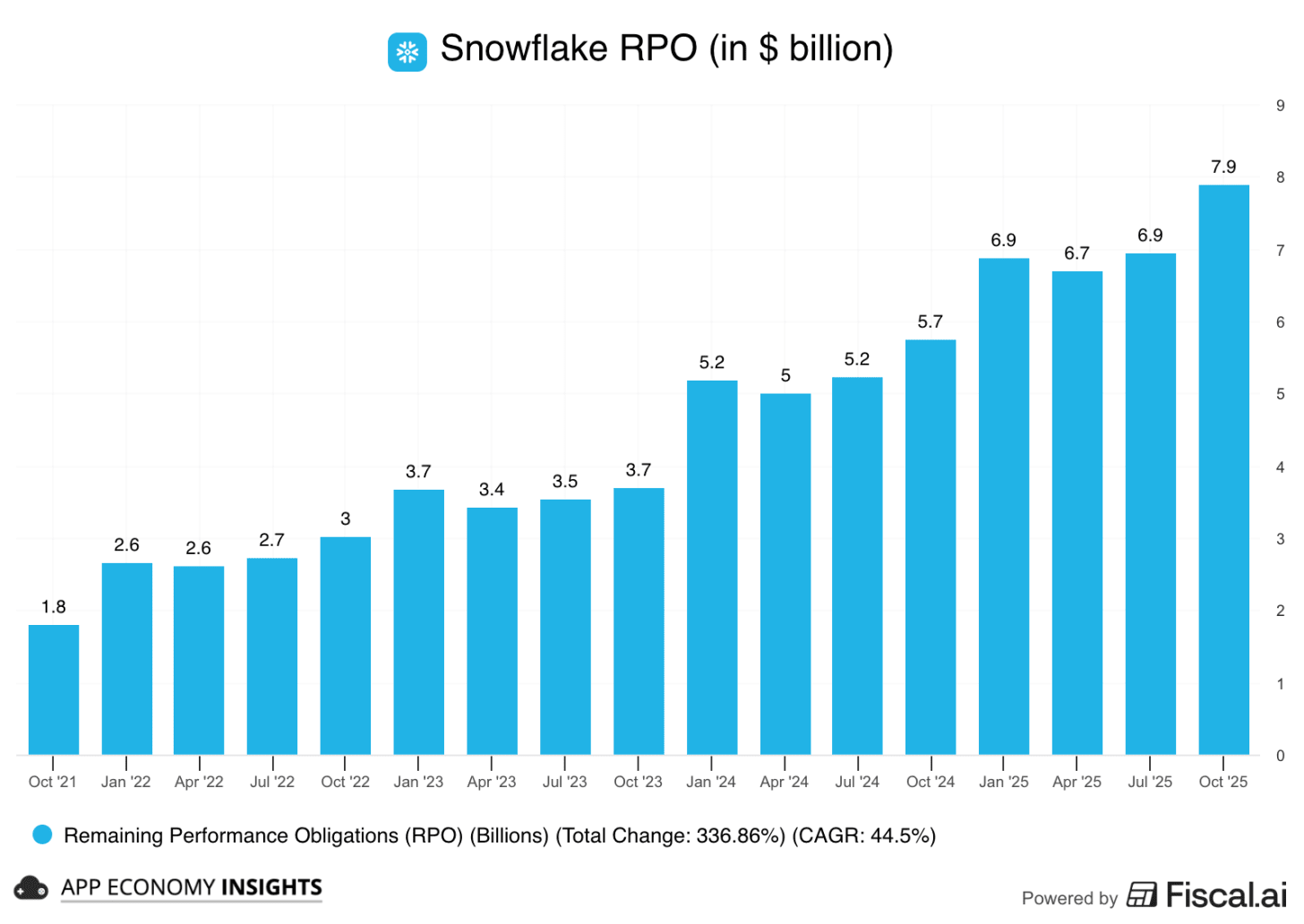
Adjusted operating margin expanded to 11% (from 6% a year ago). On a GAAP basis, it remains ugly with an operating loss margin of -27%, though it improved significantly from -39% a year ago. The main difference is stock-based compensation, which remained huge at 34% of revenue.
Large customer momentum was a standout. Snowflake signed a record four nine-figure deals in the quarter. Customers generating over $1M in product revenue grew 29% Y/Y to 688, and the company’s total customers rose 20% Y/Y to 12,261 (both metrics accelerating).
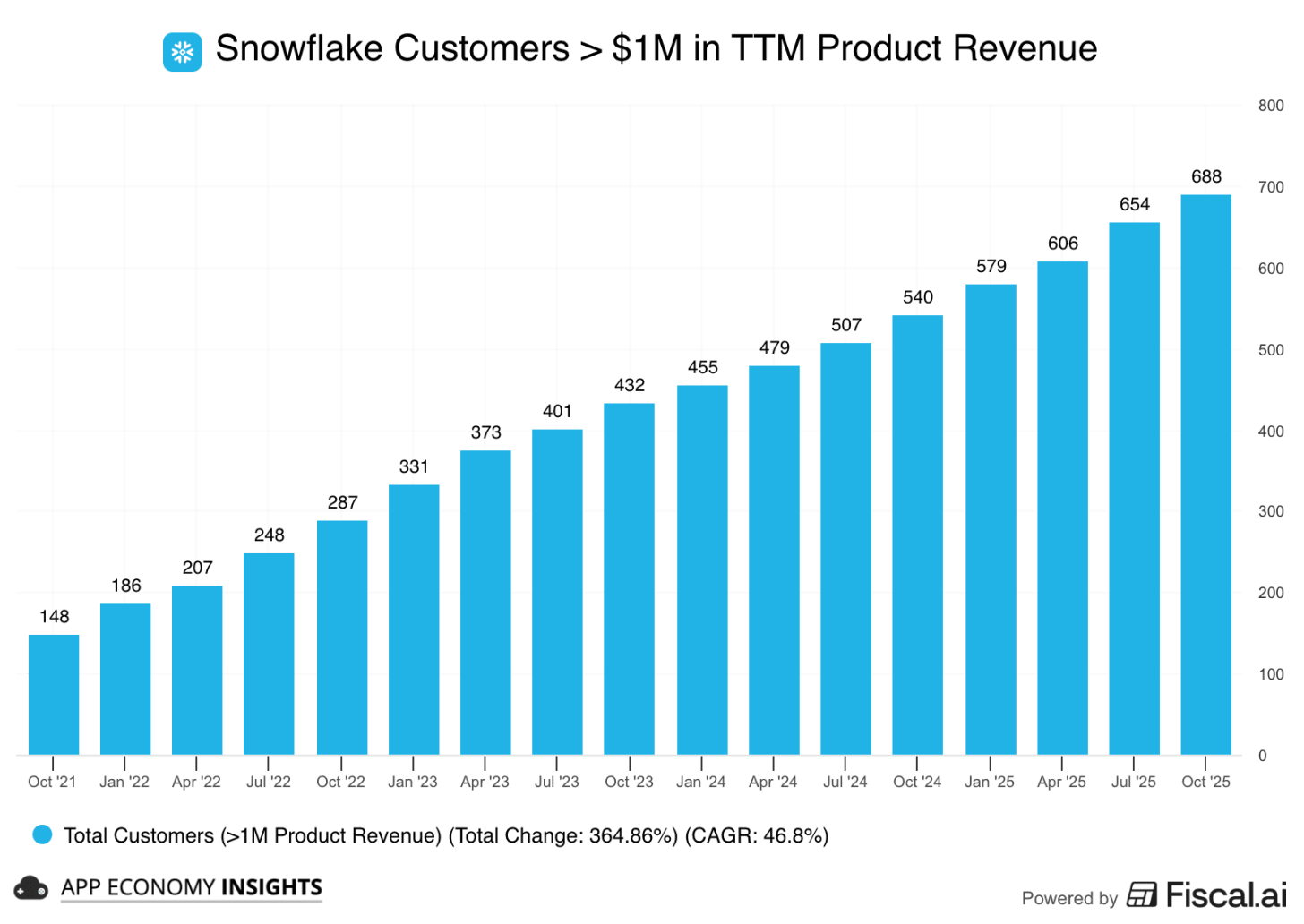
Management raised the full-year FY26 product revenue guidance by $41 million to ~$4.45 billion. However, shares fell as the Q4 operating margin guide of 7% missed consensus, implying a significant margin compression with continued AI investment.
CEO Sridhar Ramaswamy highlighted that Snowflake hit a $100 million AI revenue run rate one quarter ahead of schedule. To be sure, this is still a tiny portion of overall revenue at this stage.
Snowflake Intelligence (agentic AI) is seeing the fastest adoption ramp in company history. To bolster this, Snowflake announced a $200 million partnership with Anthropic to bring Claude models to the platform. While the margin outlook for Q4 is concerning, the acceleration in RPO and tangible AI monetization suggests the product strategy is delivering results.